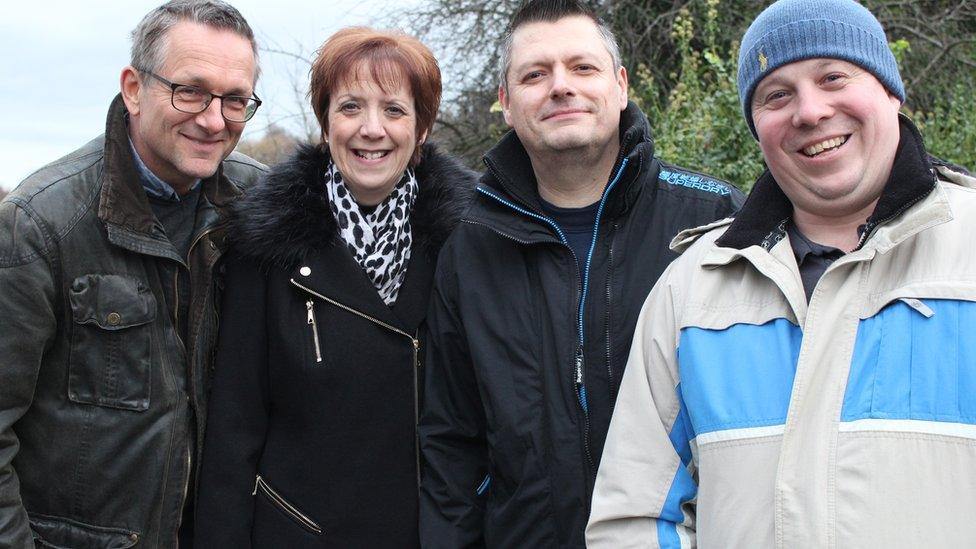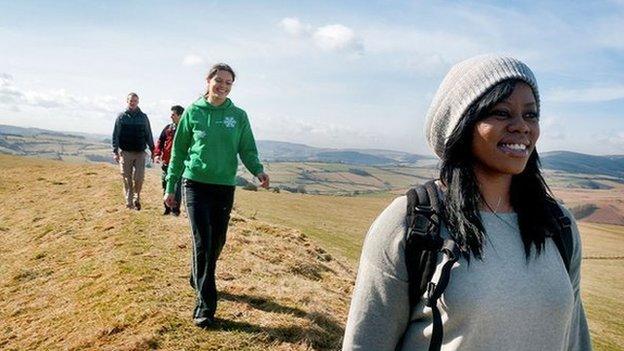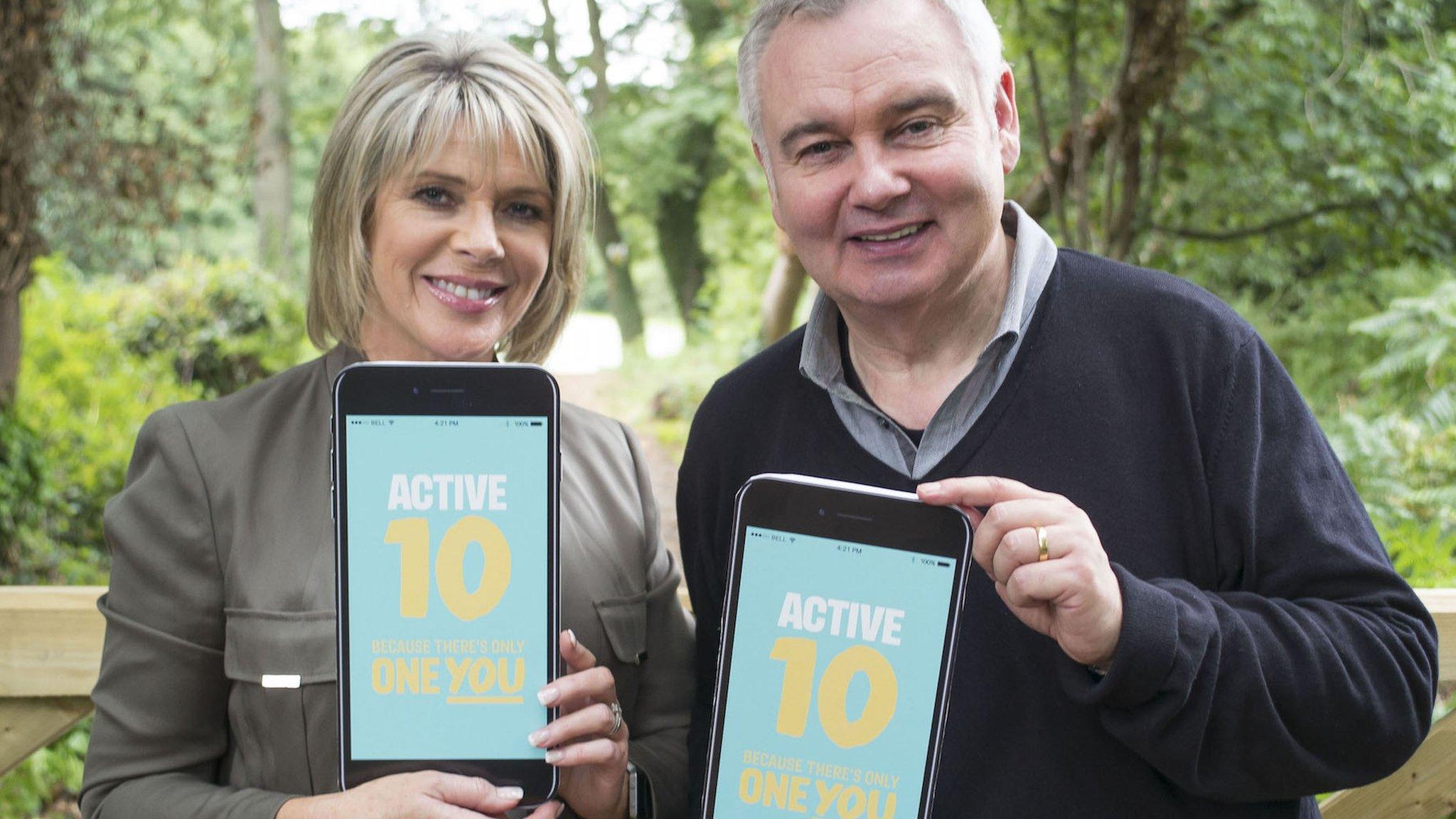Michael Mosley: 'Forget walking 10,000 steps a day'
- Published
Many people consider 10,000 steps a daily target to remain healthy
These days it is hard to walk the streets without running into someone who is anxiously looking at their wrist to see if they are on target to reach the magic 10,000 steps.
Is it really a goal worth striving for, or might there be something better?
And where did that figure come from?
You might be surprised to hear it was the result of a 1960s marketing campaign in Japan.
In the run-up to the 1964 Tokyo Olympics, a company came up with a device which they started marketing to the health-conscious.
It was called a Manpo-Kei. In Japanese, "man" means 10,000, "po" means steps and "kei" means meter. So it was, literally, a 10,000 steps meter.
The device was an early pedometer, based on the work of Dr Yoshiro Hatano, a young academic at Kyushu University of Health and Welfare.
Dr Hatano was worried that the Japanese were busy importing a slothful American lifestyle, as well as a love of watching baseball, and wanted to help them get more active.
He reckoned that if he could persuade his fellow Japanese to increase their daily steps from 4,000 to around 10,000 then they would burn off approximately 500 extra calories a day and remain slim.
That, apparently, was how the "10,000 steps a day" regime was born.
It was clearly a great marketing success. But is it still the most effective way to improve our fitness?
'Knitting is my only activity'
For The Truth about Getting Fit, I went to a factory in Sheffield with Prof Rob Copeland from Sheffield Hallam University.
Our aim was to do a small experiment in which we would compare the benefits and ease of doing 10,000 steps against something called, "Active 10, external".
With Active 10 you don't need to count steps. You simply aim to do three brisk 10-minute walks a day.
Our volunteers all had different reasons for wanting to get fitter.

Some of the volunteers who took part in our test
Dave said: "I'm very aware that I'm not as fit as I used to be and I've put a lot of weight on," while Judy confessed: "My only activity at the moment is knitting."
And Nathan, who has a six-year-old daughter, said: "She runs so fast, and I run so slowly, I can't catch her up."
Our small group of volunteers was fitted with activity monitors so we could not only monitor what they did, but also how vigorously they did it.
First, a normal day's activity was measured.
Rob then split them into two groups. One was asked to hit the 10,000-step target - around five miles - in a day, while the other group was asked to do three sessions of "Active 10" - which adds up to around 1.5 miles - more like 3,000 steps.
The Active 10 group were also told that their aim was not to amble but to get their pace up so that they would be working their heart and lungs. Prof Copeland told them: "You are aiming to walk fast enough so that you can still talk but not sing."
Brisk walks
When we looked at the volunteers' results, two out of the three asked to do 10,000 steps had managed to hit their target. But they had all struggled.
The Active 10 group, on the other hand, had found it relatively easy. They had formed a small walking group and met together at convenient times during their working day to go for a brisk walk together.
So 10,000 steps was harder to achieve - but which activity was better for health?

Better to go briskly...
Prof Copeland had analysed the data from their tracking monitors and he said the findings were very clear.
"The Active 10 group actually did 30% more 'moderate to vigorous physical activity' than the 10,000-step group, even though they moved for less time.
"And it's when you are doing moderate intensity activity that you are starting to get the greatest health benefits."
So even though the Active 10 group spent less time actually moving, they spent more time getting out of breath and increasing their heart rate.
Prof Copeland told the group: "What we really wanted you to do was to get your heart beating faster. There's lots of evidence to suggest that by doing so you can lower your risk of diabetes, cardiovascular disease and some cancers."
So three short brisk walks were easier to fit into the day and better for health.
I thought that was really interesting and I found it very encouraging, because I really don't like doing 10,000 steps.
So the fact that you can get similar, perhaps greater, benefits from a few brisk walks a day is enormously encouraging.
To start doing some Active 10s in your day go to the NHS website, external where you can download a free Public Health England app. It is a good way to see how much brisk walking you're doing, and how to do more.
The Truth About... Getting Fit is on BBC One at 20:00 on Wednesday 31 January and will be available on iPlayer afterwards.

You may also like:
- Attribution
- Published30 November 2016

- Attribution
- Published24 August 2017
